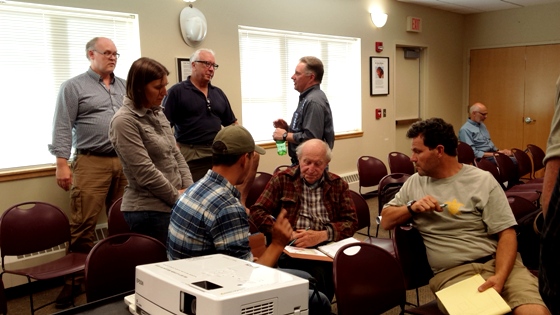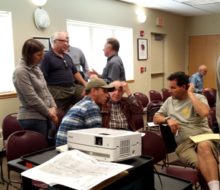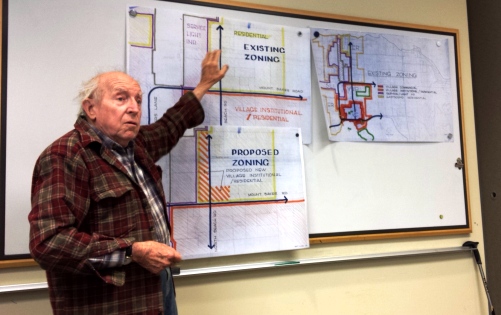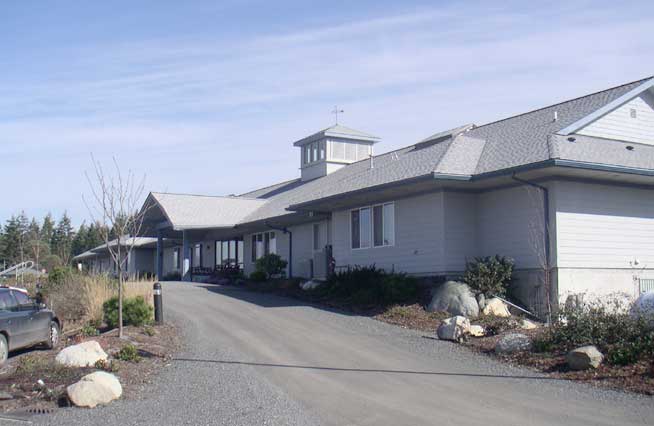— by Emma Heikkinen and Margie Doyle —

Eastsound Planning Review Committee members, Eastsound residents, County Planning Commission members, Eastsound Design Review Committee members, Chamber of Commerce staff and County Development staff confer at Eastsound Planning Review Committee Meeting last Thursday.
At the September 15 meeting of the Eastsound Planning Review Committee (EPRC), much of the discussion focused on the continued urbanization of Eastsound and efforts to maintain the area’s rural character.
Public comment opened with a suggestion from John Campbell to the committee on tying up “one of the loose ends” of last year: restructuring the split zoning at the northwest intersection of North Beach and Mt. Baker Roads. The Port of Orcas, which owns that property, would like to see the split zone (Service light industrial (SLI)/Residential ) changed to a full SLI zone.
Since that redesignation was denied last year, the Port requested that the County Council make the determination, as it is not on the annual docket schedule of items to be considered this year. The Port’s request, Campbell said, would be site-specific. He maintained that the EPRC should consider rezoning in the larger residential area. Campbell displayed maps illustrating his proposal that a portion of the area surrounding the intersection be changed from Eastsound Residential to Village Institutional/Residential, due to an increased need for institutional use in that area.
“It’s up to you to start the conversation,” Campbell told the EPRC.
“Split zoning is not the bugaboo to me that I hear from the county so often. It’s not fatal; it’s what happens when a rural area expands.
“Today we have a major intersection and a major road; it just doesn’t seem like a residential neighborhood to me,” he stated. The area has changed since 25 years ago, and now a hostel and a school are in the residential area. An estimated 12-16 tax parcels would be affected by the proposed change.
EPRC Chair Greg Ayers said the Port of Orcas continues to express the desire that the split zone be dropped and the parcel right at the corner (now used by the Off-Leash Dog Park) be designated Service Light Industrial (SLI). “The first starting point is going to the Port,” he told Campbell. Ayers said the Port was willing to make a compromise with the community and have a setback on a lot zoned fully SLI, not split-zoned as it is now.
EPRC Member Fred Klein said, “Our concern is about the overall planning issues around the village, not just the port. This is a major intersection and it calls out to have compatible zoning on all four quadrants.”
The EPRC decided that several of its members will attend the next Port meeting to discuss the zoning issue.
Ed Sutton then commented that, as a Sewer District Commissioner, “Now might be the time to expand the facilities so that we’re ahead of the curve.”
Public comment continued with Tim Blanchard’s comments on the “Seeking a Vision for Eastsound” document, prepared for discussion at an Oct. 13 Town Hall meeting co-sponsored by the EPRC and the Orcas Island Chamber of Commerce. Blanchard noted that the document does not take into account population growth throughout the next years.
“It creates some false dichotomies that drive people apart instead of bringing them together,” he said: in particular, cars vs. people. With an aging population, focusing on walking-oriented forms of transportation may be unrealistic. The document contains tone issues, as well, he noted. It’s “certainly not neutral” and “condescending” at times, and has an extreme bias towards increasing urban presence. The word ‘rural’ occurs only twice, and many proposals are “decidedly urban”, with a trend towards standardization.
“This is a reaction I’ve heard from a number of folks,” Blanchard said. He stated that people move to Orcas for an “authentic, rural” village, not a “contrived” village, city, or resort atmosphere.
“I’m not trying to pick on anybody, but want to increase the conversation,” Blanchard concluded.
EPRC member Bob Maynard responded, “What you see in that document is the people talking.” Stakeholders provided their input for the document, and it’s not from an entirely neutral source, he said.
Ayers said, “The document did what it was intended to do which was stimulate the conversation.” Later in the meeting the group assigned tasks in preparation for the Town Hall to take place on Thursday, Oct. 13 at 6 p.m. at the Senior Center.
County Community Development Director Erika Shook next gave a presentation on potential Village Residential/Institutional Street Standards to be implemented throughout the Eastsound Urban Growth Area (UGA). She showed slides of new concepts for a “softer urban edge” with low-impact development and water quality standards, rather than applying current village core street standards onto a larger area. The proposed standards are planned to look more rural, while still providing safety to pedestrians, in particular people with disabilities and aging people. The current standards seem too “intense” to be applied to all of the properties within the Village Residential/Institutional District, Shook said.
County Planning Engineer Colin Huntemer stated that the plan is to gradually transition the area from rural on the outer edges, to curbs in the middle, eventually ending with urban standards in the core “downtown” area. — “something between” the downtown standard for sidewalks, curbs, and gutters, to rural areas, as to not have a sharp divide.
OPAL Executive Director Lisa Byers asked if the OPAL rental project triggered the development of new standards. Shook said that she “doesn’t want to make a standard that’s just project-specific.”
Byers continued to question if the standards would apply to the OPAL project planned along North Beach Road, south of Mt. Baker Road. County Engineer Colin Huntemer said that all who develop property in that area would be required to “extend street standards.”
Ayers said, “I didn’t anticipate the breadth of this [proposal]”.
Byers said, “[What is planned for the OPAL project] is a bioswale and path in line with what exists now. I’m balking that we have to put in curbs along North Beach, that’s kind of a curve ball.”
EPRC Members tended to concur with Byers, and made some suggestions to modify the plan.
Huntemer said “Right now all we have are standards of 1990 evolution.” He said his opinion was that it would be good “to have something in between Mt Baker Road and North Beach Road. The code as written now [shows] that the intent may not have been completely understood. We think it might deserve some attention.”
Ayers suggested that it may be better to consider changes within zones. He pointed out that Shook submitted the drawings to the EPRC as a response to street standards, and said, “Nobody’s been given notice that we’re about to change street standards to affect other people’s properties.”
Maynard asked if OPAL’s project might be considered an exception, saying “To hold this up now is crazy and also irresponsible.”
Shook said that county staff were “not expecting a decision today, but looking at a path forward.”
Ayers indicated it would be put on the agenda for the October 6 meeting and said, “I’m sensitive to OPAL’s need to move forward, but we need to hear from the community.”
Like what you just read? Subscribe to the daily “headlines” from OrcasIssues.com. Go to orcasissues.com/
**If you are reading theOrcasonian for free, thank your fellow islanders. If you would like to support theOrcasonian CLICK HERE to set your modestly-priced, voluntary subscription. Otherwise, no worries; we’re happy to share with you.**











OK Orcas, it’s decision time. When we build housing, we build culture. So, if we build apartment housing and cheek-by-jowl housing in Eastsound, we are going to create a section of the island that houses primarily the working class and the poor.
Do we want this?
Or, would we rather have de-segregation by allowing a second guest house on private parcels throughout the Island? (This was originally Rick Hughes’ idea when he was running for County Council the first time.)
This kind of rural development would allow the needed housing for the working class people to be in beautiful rural settings, which is precisely the reason people want to live on Orcas.
So, do we want to concentrate further the service/working class people of Orcas into Eastsound, and create class-distinction on Orcas based on residential area? Or, do we want to de-segregate and allow the working class people of Orcas to live on land and in housing that allows them to have a piece of island-life as well?
I think it’s a no-brainier, and I personally caution you all against turning Eastsound into slums. It will be a sorry sight for Orcas if you take that path.
Here is the determiner for you: Build housing that you yourself would want to live in! It’s simple!
We don’t need more stack-em and pack-em housing on Orcas! It will breed poverty and strife!
Allow second guest houses on private parcels and we will have increased housing in beautiful settings, a construction boom, as well as new income opportunities for landowners.
Segregation is good for no-one and unity heals everything. What do we really want to see here?
If you want the second guest house option to be a reality I suggest you contact the County Council and tell them right away. They can only represent the people who talk with them. “Love thy neighbor as thy self”!! -Domenic Verbano
While I’m not sure that it would replace the need for the new OPAL rental project, I certainly agree that we should return to the guest house tradition on private parcels to address the needs and desires of homeowners, which include providing long-term rentals for Orcas residents in generally appealing rural areas while providing income to the owner and allowing space for family visitors or for a caretaker.
The traditional guest house permission was surrendered by the County Council in a settlement, despite the overwhelming support for the concept from the people of the County. It is well worth revisiting that topic now.
There is a fundamental reality to the issue of density and land use, that being the Growth Management Act. As I recall, the GMA directs that 1/2 of projected growth of a community be located within designated UGAs (Urban Growth Areas). I believe that by definition, the GMA discourages doubling housing densities by way of guest houses. Please correct me if my memory is fuzzy.
On a different issue, I have said repeatedly as a very long-term resident of Eastsound, that I do not favor detailed planning elements that transforms Eastsound as a picturesque rural village into another Friday Harbor. I can’t support any plan that requires curbs, gutters and eventually sidewalks beyond the area that we residents consider to be the Eastsound village. Stop the village planning at the corner of North Beach Rd and School Rd.
I much prefer the idea of “close-in” rural housing in the latest OPAL project without the urbanization of streetscapes and concrete. There was a time when Eastsound was just a quiet, pleasant, sleepy little village. I much prefer my home as it was, long before the planning pressures to have it conform to some bureaucrat’s idea of a “cutesy” village.
Good meaningful comments from each of you…let’s consider both solutions to the housing conundrum…both allow guest houses that are not short term rentals…and
dense well planned projects like Opal that are attractive and well maintained so that they do not become slums.our community needs both approaches to resolve this
crisis and provide a decent home so people don’t have to live in their cars !
The GMA does require that the County plan for 1/2 of all growth to occur within the UGA. There is no way to force people to live in the UGA, however. If I recall correctly, guesthouses are still permitted on small lots in the UGA.
The GMA doesn’t set a bright-line density limit. After a referendum in which some 70+% of County voters expressed support for detached guesthouses on 5 acre lots and above, the ordinance that permitted such guesthouses was challenged and the issue worked its way up to the state appellate court, strongly defended by the County. Many of us expected the court to address that bright-line issue, but the newly-elected Council directed that the litigation be settled, precluding guesthouses on 5-acre lots, except for a few each year that could meet very challenging requirements.
I always felt that the “double-density” argument raised in the appeal was a bit disingenuous, given County findings that a large proportion of guesthouses were used only for the summer, or part of it.
I think that restoring the island tradition of guesthouses on lots of 5 acres or more would be one way to provide some relief in affordable housing opportunities for long-term rentals or caretaking in guesthouses, as well as letting homeowners to have a place for visitors–all without visually “crowding” our rural areas..
We must have bike lanes on North Beach Road between School Road and Mt. Baker Road. This is a no-brainer! This stretch is hazardous!
I can’t visualize how a Bike lane would fit into the road right-of-way between School Rd and Mt Baker Rd without whacking down a LOT of trees. Bad idea. On the opposite side of the road is a gravel walking trail. It is not unreasonable to share that trail with bicyclists.
Here we go again: save the trees, so we can keep our roads quaint, narrow and dangerous!? According to the law, bikes have rights to the road. I’m sure you’ve noticed them riding on that road. They’re not going to stop, because like it or not, bikes are here to stay. Town to North Beach would actually be a great commute on a bike if there were bike lanes. Separate bike paths are fine, too, as long as they’re paved and wide enough to accommodate both pedestrians and bikes. But they are an alternative, not a requirement for cyclists.